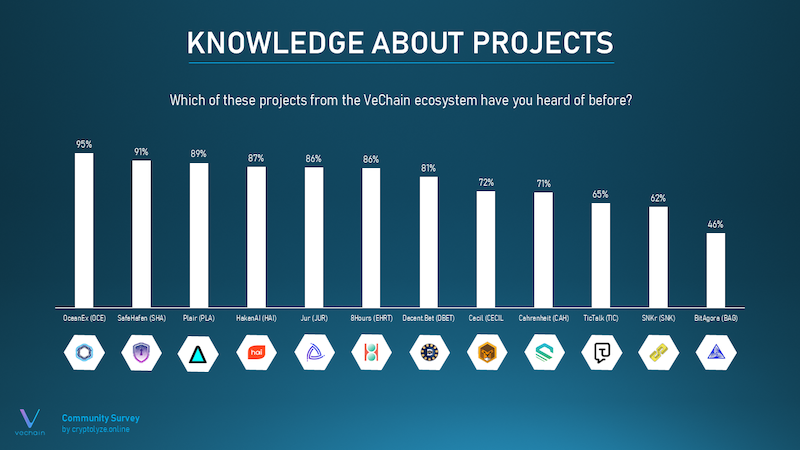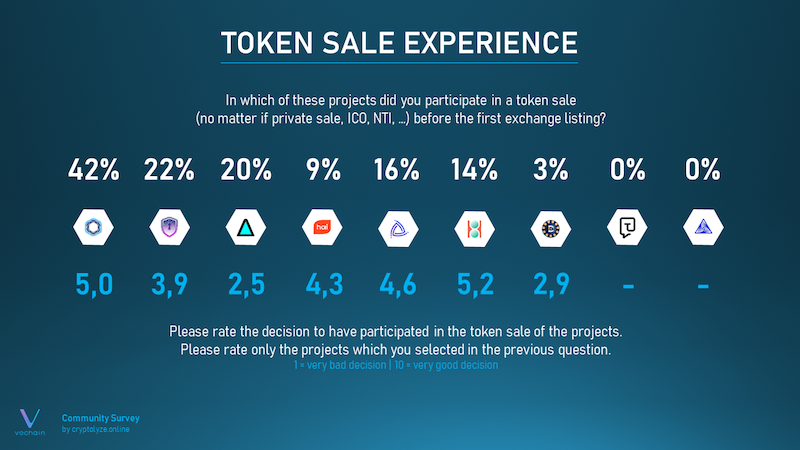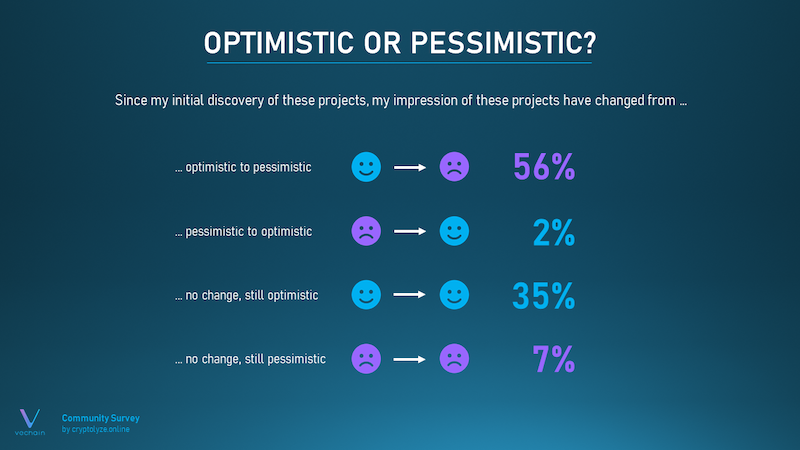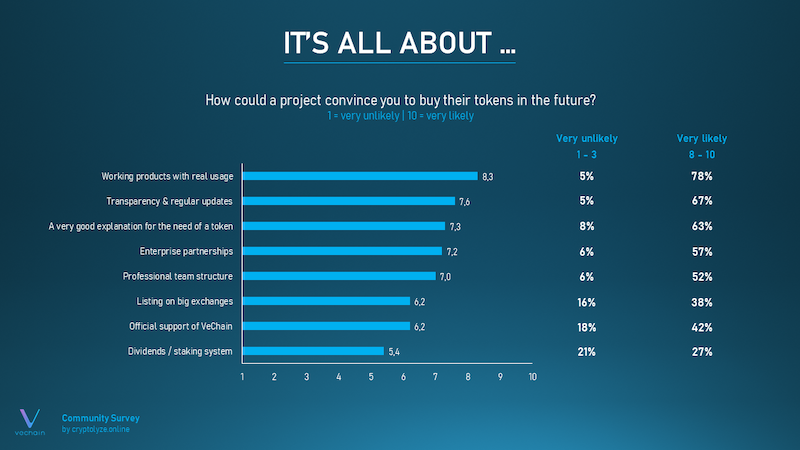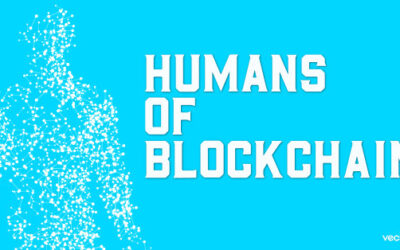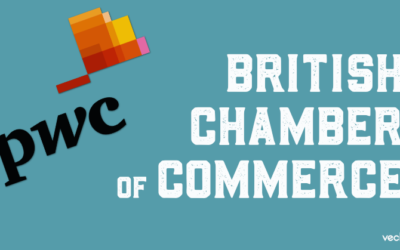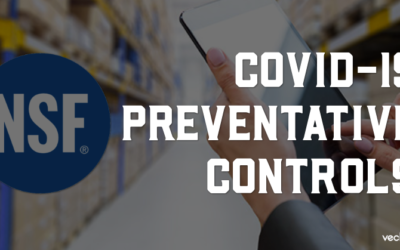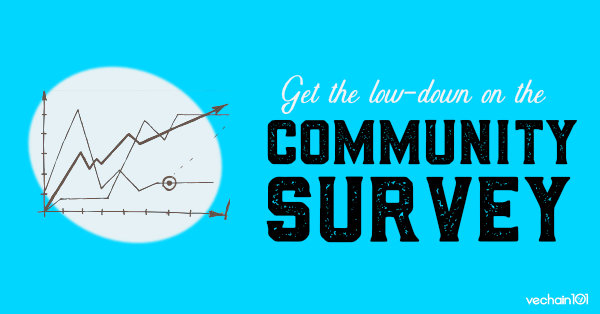
Community Survey Summary: VeChain Ecosystem Token Projects (Third-Party Edition)
From May 23rd to May 27th Tim from Cryptolyze conducted another one of his well-known community surveys about VeChain related topics.
Tim: This time it was all about the projects which are part of the VeChain ecosystem. Among other things, it asked how users rate the chance of success for various projects they have invested in and how they evaluated the impact of these projects on VeChain in general. 323 people participated in the survey, the results of which are summarized here.
Most of the projects are well known to the VeChain Community with ratings way over 80%. OceanEx led the way with 95%. Projects without a token sale like Cecil and CAHrenheit as well as failed projects like TicTalk received lower ratings.
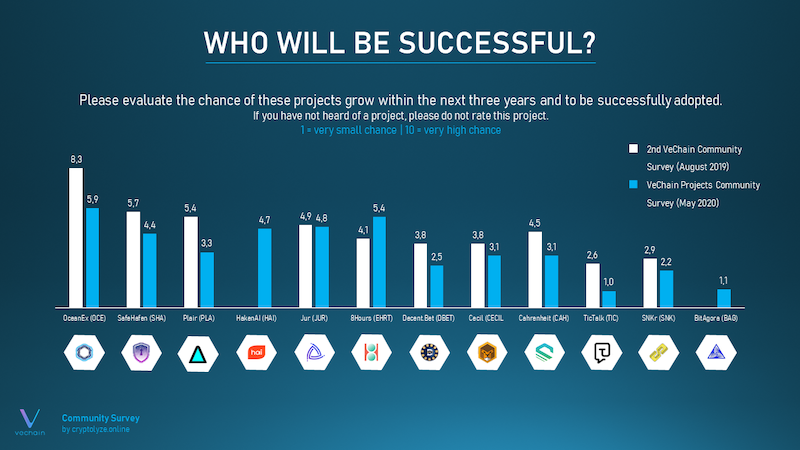
Having asked this question in the 2nd VeChain Community Survey in August 2019 before, I was able to compare the ratings of most projects with the newer results. Almost all projects fell into disfavor with the participants, most drastically with OceanEx and Plair. The winner of this question was the 8Hours Foundation, which actually improved.
Fewer and fewer people participate in token sales of newer projects. OceanEx had the most participants. However, no project was really convincing – there were only mediocre ratings at most. The investors of Plair are particularly dissatisfied. A similar picture emerges with the buyers of tokens on exchanges. Plair, Decent.Bet, as well as the failed projects Tic Talk and BitAgora are rated very negatively, the rest are rated mediocre. The best value was once again 8Hours.
The participants were also confronted with a number of statements about the projects and their influence on VeChain.
58% agreed that the projects in the VeChain ecosystem are a disappointment in general and a similar number (60%) thinks that failed projects damage the reputation of VeChain as a whole. That’s why 72% said that VeChain should be more selective about which projects become part of the ecosystem even though 67% like the promotion VeChain is offering those projects on their official social media platforms.
A small majority of 57% thinks that those projects are important for the success of VeChain. A great number of participants (83%) have the opinion that a big number of transactions on the VeChain mainnet can be generated by the named projects. At the same time, 63% felt that enterprise clients were more important.
As to the question whether those projects are acting in good faith and put the interest of the project and investors ahead of their own, the community seems to have a divided point of view. 50% agreed whilst the other half continues to believe in the good intentions of the projects.
A disastrous result was the question of the participants’ attitude towards the projects. More than half (56%) stated that their own viewpoint changed from optimistic to pessimistic. Hardly anyone who was previously pessimistic is now optimistic (2%). Overall, almost two-thirds take a pessimistic position.
Finally, the question arose as to how the projects could improve these poor to mediocre results in the future. The community sees the greatest potential in working products, more transparency and a precise description of the token usage. Interestingly, the official support of VeChain plays a rather minor role.
Some key takeaways
In summary, it can be said that the euphoria around the projects in the VeChain ecosystem seems to have been given a massive dose of reality. In order for the community to become more optimistic again, the projects – as well as projects outside the VeChain ecosystem – must now prove their suitability in the real world. The mandate for working products with real usage is clear: hype, roadmaps and rumors are no longer driving investors to buy small marketcap tokens. Certainly the technology is mostly there from an infrastructure perspective. Now it’s about removing key bottlenecks, including more robust wallet solutions, easier Fiat-to-Crypto (and vise-versa) methods, and more productive community outreach to grow the potential user base. These responsibilities are shared by both the VeChain Foundation, projects, and of course community projects looking to work together.

